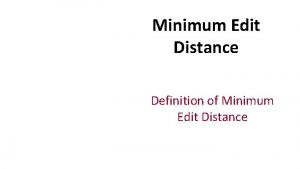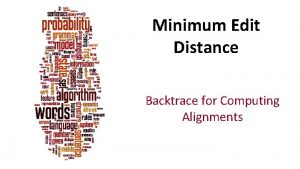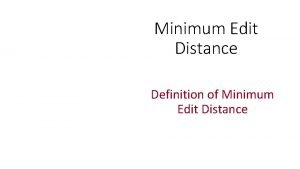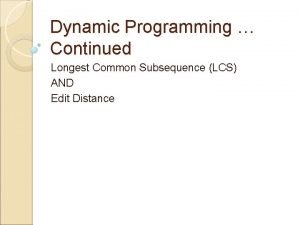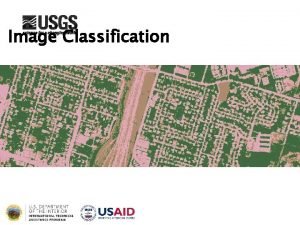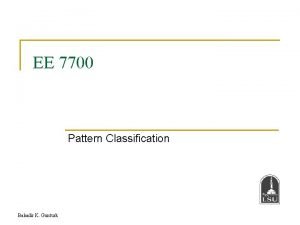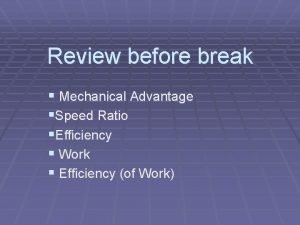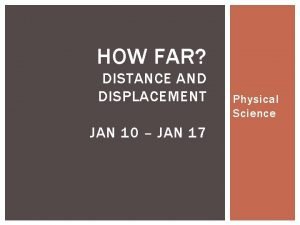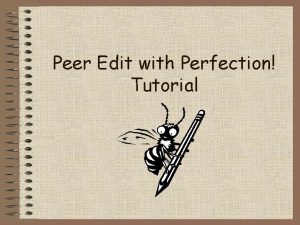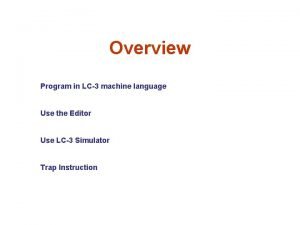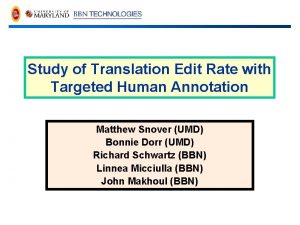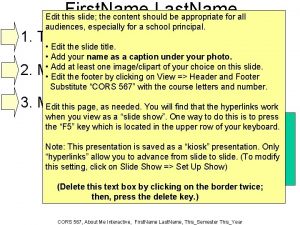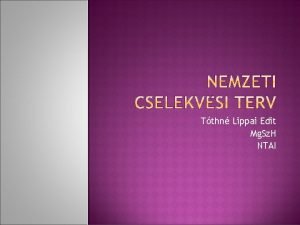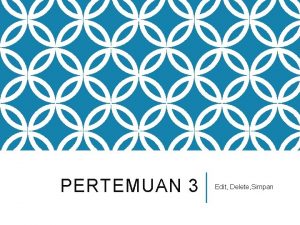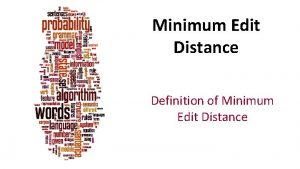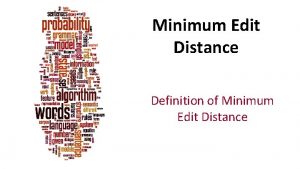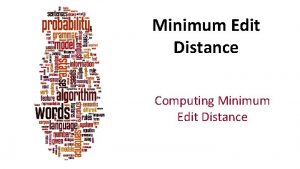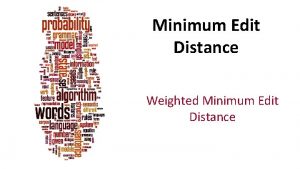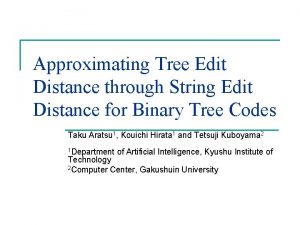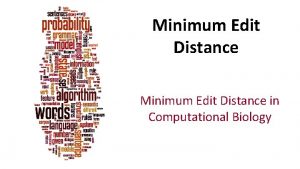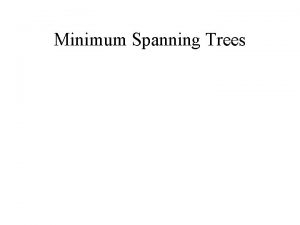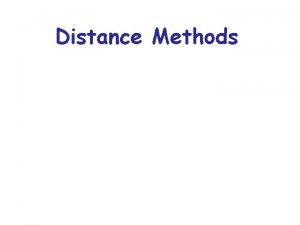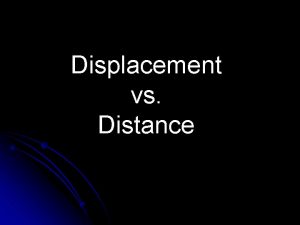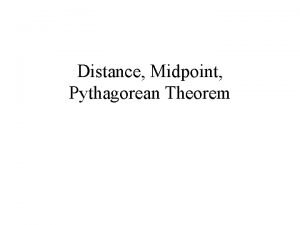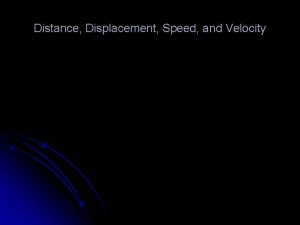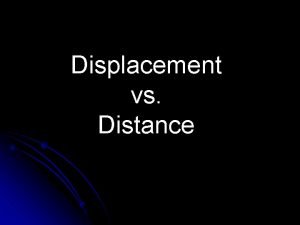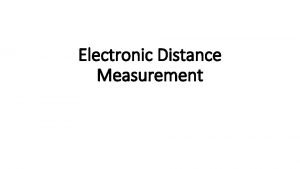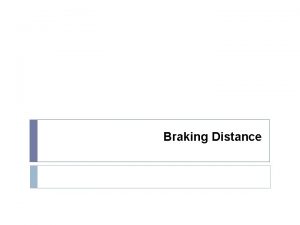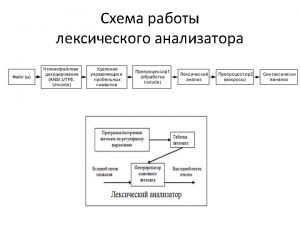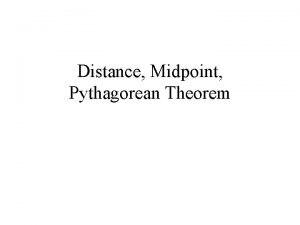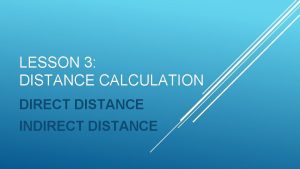Minimum Edit Distance Definition of Minimum Edit Distance








































- Slides: 40

Minimum Edit Distance Definition of Minimum Edit Distance

How similar are two strings? • Spell correction • The user typed “graffe” Which is closest? • • graft grail giraffe • Computational Biology • Align two sequences of nucleotides AGGCTATCACCTGACCTCCAGGCCGATGCCC TAGCTATCACGACCGCGGTCGATTTGCCCGAC • Resulting alignment: -AGGCTATCACCTGACCTCCAGGCCGA--TGCCC--TAG-CTATCAC--GACCGC--GGTCGATTTGCCCGAC • Also for Machine Translation, Information Extraction, Speech Recognition

Edit Distance • In computational linguistics and computer science, edit distance is a way of quantifying how dissimilar two strings (e. g. , words) are to one another by counting the minimum number of operations required to transform one string into the other. • Levenshtein distance (LD) is a measure of the similarity between two strings, which we will refer to as the source string (s) and the target string (t). The distance is the number of deletions, insertions, or substitutions required to transform s into t. 3

Edit Distance • The minimum edit distance between two strings • Is the minimum number of editing operations • Insertion • Deletion • Substitution • Needed to transform one into the other

Minimum Edit Distance • Two strings and their alignment:

Minimum Edit Distance • If each operation has cost of 1 • Distance between these is 5 • If substitutions cost 2 (Levenshtein) • Distance between them is 8

Alignment in Computational Biology • Given a sequence of bases AGGCTATCACCTGACCTCCAGGCCGATGCCC TAGCTATCACGACCGCGGTCGATTTGCCCGAC • An alignment: -AGGCTATCACCTGACCTCCAGGCCGA--TGCCC--TAG-CTATCAC--GACCGC--GGTCGATTTGCCCGAC • Given two sequences, align each letter to a letter or gap • Especially, in bioinformatics, it can be used to quantify the similarity of DNA sequences, which can be viewed as strings of the letters A, C, G and T.

Other uses of Edit Distance in NLP • Evaluating Machine Translation and speech recognition R Spokesman confirms senior government adviser was shot H Spokesman said the senior adviser was shot dead S I D I • Named Entity Extraction and Entity Coreference • • IBM Inc. announced today IBM profits Stanford President John Hennessy announced yesterday for Stanford University President John Hennessy

How to find the Min Edit Distance? • Searching for a path (sequence of edits) from the start string to the final string: • • Initial state: the word we’re transforming Operators: insert, delete, substitute Goal state: the word we’re trying to get to Path cost: what we want to minimize: the number of edits 9

Minimum Edit as Search • But the space of all edit sequences is huge! • We can’t afford to navigate naïvely • Lots of distinct paths wind up at the same state. • We don’t have to keep track of all of them • Just the shortest path to each of those revisited states. 10

Defining Min Edit Distance • For two strings • X of length n • Y of length m • We define D(i, j) • the edit distance between X[1. . i] and Y[1. . j] • i. e. , the first i characters of X and the first j characters of Y • The edit distance between X and Y is thus D(n, m)

Dynamic Programming for Minimum Edit Distance • Dynamic programming: A tabular computation of D(n, m) • Solving problems by combining solutions to subproblems. • Bottom-up • We compute D(i, j) for small i, j • And compute larger D(i, j) based on previously computed smaller values • i. e. , compute D(i, j) for all i (0 < i < n) and j (0 < j < m)

Defining Min Edit Distance (Levenshtein) • Initialization D(i, 0) = i D(0, j) = j • Recurrence Relation: For each i = 1…M For each j = 1…N D(i-1, j) + 1 D(i, j)= min D(i, j-1) + 1 D(i-1, j-1) + 2; if X(i) ≠ Y(j) 0; if X(i) = Y(j) • Termination: D(N, M) is distance

Computing alignments • Edit distance isn’t sufficient • We often need to align each character of the two strings to each other • We do this by keeping a “backtrace” • Every time we enter a cell, remember where we came from • When we reach the end, • Trace back the path from the Lower right corner to read off the alignment

Adding Backtrace to Minimum Edit Distance • Base conditions: D(i, 0) = i Termination: D(0, j) = j D(N, M) is distance • Recurrence Relation: For each i = 1…M For each j = 1…N D(i-1, j) + 1 D(i, j)= min D(i, j-1) + 1 D(i-1, j-1) + 2; if X(i) ≠ Y(j) 0; if X(i) = Y(j) insertion LEFT deletion ptr(i, j)= DOWN DIAG substitution deletion insertion substitution

Weighted Edit Distance``` • Why would we add weights to the computation? • Spell Correction: some letters are more likely to be mistyped than others • Biology: certain kinds of deletions or insertions are more likely than others

Confusion matrix for spelling errors


Weighted Min Edit Distance • Initialization: D(0, 0) = 0 D(i, 0) = D(i-1, 0) + del[x(i)]; D(0, j) = D(0, j-1) + ins[y(j)]; 1<i≤N 1<j≤M • Recurrence Relation: D(i-1, j) + del[x(i)] D(i, j)= min D(i, j-1) + ins[y(j)] D(i-1, j-1) + sub[x(i), y(j)] • Termination: D(N, M) is distance

Sequence Alignment AGGCTATCACCTGACCTCCAGGCCGATGCCC TAGCTATCACGACCGCGGTCGATTTGCCCGAC -AGGCTATCACCTGACCTCCAGGCCGA--TGCCC--TAG-CTATCAC--GACCGC--GGTCGATTTGCCCGAC

Sequence Alignment • A sequence alignment is the way of arranging the sequences of DNA, RNA and Proteins to identify the regions of similarity that may be consequence of functional, structural or evolutionary relationship between the sequences.

Why sequence alignment? • Comparing genes or regions from different species • to find important regions • determine function • uncover evolutionary forces • Assembling fragments to sequence DNA • Compare individuals to looking for mutations

Alignments in two fields • In Natural Language Processing • We generally talk about distance (minimized) • And weights • In Computational Biology • We generally talk about similarity (maximized) • And scores

Global Alignment: Global alignment is useful when you want to force two sequences to align over their entire length. Needs to find relationship between two sequences as a whole The Needleman-Wunsch Algorithm

The Needleman-Wunsch Algorithm • Initialization: D(i, 0) = -i * d D(0, j) = -j * d • Recurrence Relation: D(i-1, j) - d D(i, j)= max D(i, j-1) - d D(i-1, j-1) + s[x(i), y(j)] • Termination: D(N, M) is distance

The Needleman-Wunsch Algorithm • Initial Matrix of two strings http: //vlab. amrita. edu/? sub=3&brch=274&sim=1431&cnt=1

The Needleman-Wunsch Algorithm • Initialization: http: //vlab. amrita. edu/? sub=3&brch=274&sim=1431&cnt=1

The Needleman-Wunsch Algorithm Alignment Scores: • Match =+1 • Mismatch=-1 (Subs) • Gap=-1 (Ins, Del=indels) http: //vlab. amrita. edu/? sub=3&brch=274&sim=1431&cnt=1

The Needleman-Wunsch Algorithm • Possible Alignments with Trace backs

The Needleman-Wunsch Algorithm T C G C A TCGCA TC-CA T C C A

Local Alignment • Local alignment methods find related regions within sequences - they can consist of a subset of the characters within each sequence. • For example, positions 20 -40 of sequence A might be aligned with positions 50 -70 of sequence B. • This is a more flexible technique than global alignment and has the advantage that related regions which appear in a different order in the two proteins (which is known as domain shuffling) can be identified as being related. • This is not possible with global alignment methods.

The Smith-Waterman algorithm • • Place each sequence along one axis Place score 0 at the up-left corner Fill in 1 st row & column with 0 s Fill in the matrix with max value of 4 possible values: – – 0 Vertical move: Score + gap penalty Horizontal move: Score + gap penalty Diagonal move: Score + match/mismatch score • The optimal alignment score is the max in the matrix • To reconstruct the optimal alignment, trace back where the MAX at each step came from, stop when a zero is hit

The Smith-Waterman algorithm Idea: Ignore badly aligning regions Modifications to Needleman-Wunsch: Initialization: F(0, j) = 0 F(i, 0) = 0 Iteration: F(i, j) = max 0 F(i – 1, j) – d F(i, j – 1) – d F(i – 1, j – 1) + s(xi, yj) Slide from Serafim Batzoglou

Local alignment example X = ATCAT Y = ATTATC Let: m = 1 (1 point for match) d = 1 (-1 point for del/ins/sub) A T C A T T A T C 0 0 0

Local alignment example X = ATCAT Y = ATTATC A T 0 0 0 A 0 1 0 T 0 0 2 1 0 2 T 0 0 1 1 0 0 A 0 1 0 0 2 1 T 0 0 2 1 1 3 C 0 0 0 3 2 2

Local alignment example X = ATCAT Y = ATTATC A T 0 0 0 A 0 1 0 T 0 0 2 1 0 2 T 0 0 1 1 0 0 A 0 1 0 0 2 1 T 0 0 2 1 1 3 C 0 0 0 3 2 2

Local alignment example X = ATCAT Y = ATTATC A T 0 0 0 A 0 1 0 T 0 0 2 1 0 2 T 0 0 1 1 0 0 A 0 1 0 0 2 1 T 0 0 2 1 1 3 C 0 0 0 3 2 2


Global vs. Local Alignments • Global alignment algorithms start at the beginning of two sequences and add gaps to each until the end of one is reached. • Local alignment algorithms finds the region (or regions) of highest similarity between two sequences and build the alignment outward from there.

Global versus local alignments Global alignment: align full length of both sequences. “Needleman-Wunsch” algorithm). (The Global alignment Local alignment: find best partial alignment of two sequences (the “Smith-Waterman” algorithm). Seq 1 Local alignment Seq 2
 Minimum edit distance nlp
Minimum edit distance nlp Minimum edit distance backtrace
Minimum edit distance backtrace Attatc
Attatc Hard edit vs soft edit
Hard edit vs soft edit Edit distance dynamic programming
Edit distance dynamic programming Local maximum and minimum
Local maximum and minimum Headed concrete anchors
Headed concrete anchors Minimum distance classifier
Minimum distance classifier Minimum distance classifier
Minimum distance classifier Bahadir gunturk
Bahadir gunturk The ratio of input distance to output distance
The ratio of input distance to output distance Distance and displacement
Distance and displacement Kriston edit
Kriston edit Kronos historical edit
Kronos historical edit Quick edit+
Quick edit+ Peer editing
Peer editing Edit decision list
Edit decision list Please feel free to edit
Please feel free to edit Every day edit
Every day edit Bioedit
Bioedit Multiply in lc3
Multiply in lc3 Frivaldszky edit
Frivaldszky edit @qussaiomarii:https://forms.gle/1fbyoualyf1wnwt19
@qussaiomarii:https://forms.gle/1fbyoualyf1wnwt19 Yang merupakan modus edit, kecuali
Yang merupakan modus edit, kecuali Daily oral language paragraphs
Daily oral language paragraphs Gene edit
Gene edit How to edit and publish a video with maker
How to edit and publish a video with maker Click to edit master title style
Click to edit master title style Writing broadcast news
Writing broadcast news Translation edit rate
Translation edit rate Cimco edit cena
Cimco edit cena Edit
Edit Click to edit master title style
Click to edit master title style Click to edit master title style
Click to edit master title style Name edit
Name edit Edit
Edit 오렌지 프로시저 디버깅
오렌지 프로시저 디버깅 Hva betyr edit
Hva betyr edit Cégértékelés
Cégértékelés H@ntai
H@ntai Menu edit adalah
Menu edit adalah
